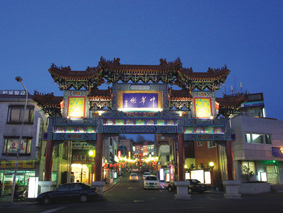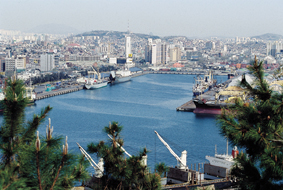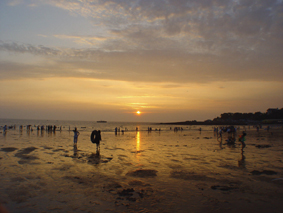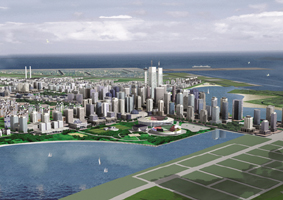Incheon Full of Dynamic Tourist
Spots, Combining Tradition, Modernity
Metropolitan city gov't. strives to tap Korean Wave and other tourist resources
 In sync with the Korean Wave raging across Asia, Incheon Metropolitan City is striving to exploit the film and TV industries as well as tourism industries by developing tourist products capitalizing on the existing sets and locations of hit dramas and meeting residents'cultural demands, said Byeon Cheon-soo, director-general of Culture, Tourism and Sports Bureau at the Incheon Metropolitan City government.
In sync with the Korean Wave raging across Asia, Incheon Metropolitan City is striving to exploit the film and TV industries as well as tourism industries by developing tourist products capitalizing on the existing sets and locations of hit dramas and meeting residents'cultural demands, said Byeon Cheon-soo, director-general of Culture, Tourism and Sports Bureau at the Incheon Metropolitan City government.
"The city government has provided 2.74 billion won in financial support for accommodating the locations of Hallyu (Korean Wave) hit dramas - such as a location used in the 2004 hit drama "Full House"in Bukdo-myeon, Onjin-gun, Incheon Metropolitan City, "Sad Love Story"and "Daughters of Kim's Pharmacy"in 2005, "Lover"in 2006 and "Knife Master Oh Soo-jung"in 2007. This step is designed to nurture the value-added tourist resources and invigorate the regional economy,"he said. The following are excerpts of his written interview with NewsWorld on the government's
 steps to promote the tourist industry and explore tourism resources.
steps to promote the tourist industry and explore tourism resources.
Question: Will you tell our readers about the Incheon Metropolitan City government's plans to promote the city's tourism industry by making the most of Hallyu, or the Korean Wave?
Answer: As the Korean Wave, the recent surge in the popularity of Korean popular culture, rages in Asia, foreign tourists are streaming into the Incheon-based locations and sets of such hit dramas as "Stairway to Heaven," "Full House,"and "Sad Love Story."
Our municipal government's plan to make the Korean Wave part of the tourism industry has been ongoing since 1996. Korea's efforts to spread the Korean Wave have gone beyond the popularity of Korean foods to such areas as cinema, television dramas and music.
In sync with this trend, the city government has provided 2.74 billion won in financial support for accommodating the locations of Hallyu hit dramas - a location used in the 2004 hit drama "Full House"in Bukdo-myeon, Onjin-gun, Incheon Metropolitan City,
 "Sad Love Story"and "Daughters of Kim's Pharmacy"in 2005, "Lover"in 2006 and "Knife Master Oh Soo-jung"in 2007. This step is designed to nurture the value-added tourist resources and invigorate the regional economy.
"Sad Love Story"and "Daughters of Kim's Pharmacy"in 2005, "Lover"in 2006 and "Knife Master Oh Soo-jung"in 2007. This step is designed to nurture the value-added tourist resources and invigorate the regional economy.
Incheon Metropolitan City has set aside 1.7 billion won for supporting the city's bid to be the setting for the dramas. Besides, the city government is striving to exploit cinema and drama filming as well as tourism industries by developing tourist products capitalizing on the existing sets and locations of hit dramas as well as meeting residents'cultural demands.
Q: Will you introduce the international culture and tourism festivals that the municipal government hosts?
A: Incheon Metropolitan City organizes world-class cultural festivals tailored to make the best use of such geographical features as Incheon International Airport, Incheon Port and Korea's largest Chinatown.
First, take a look into the Incheon Pentaport Rock Festival that has been held every year since 2006 as one of Korea's largest and representative rock festivals with world-class rock artists from Korea and abroad participating and the attendance of spectators rising. The 2nd Incheon Pentaport Rock Festival, held at the Songdo Resort from July 27 through July 29, 2007, offered diverse programs for spectators to enjoy, including the "Fun Zone"and the "Food Zone"besides the rock music and attracted a total of about 50,000 spectators, including some 3,000 foreigners. The Incheon Pentaport Rock Festival has become a music fest with the attendance of Korean visitors and foreign spectators on the rise every year.
Incheon China Festival, celebrating its sixth anniversary this year, has been evolving into the largest Chinese festival in Korea, highlighting diverse experiences including traditional Chinese culture, performances, cuisine and costumes. Incheon China Festival 2007 took place from Oct. 12 through Oct. 14 in celebration of the 15th anniversary of the establishment of Korean-Chinese diplomatic ties. During the latest festival,
 Incheon Metropolitan City and its Chinese sister city, Tianjin formed a joint performing troupe to present traditional Chinese performances.
Incheon Metropolitan City and its Chinese sister city, Tianjin formed a joint performing troupe to present traditional Chinese performances.
Incheon Ocean Festival takes place in August every year at Wangsan Beach to capitalize on its geographical merits as a maritime city. The festival serves as one of the nation's largest magnets for summer holidaymakers who can experience diverse sea events, including marine leisure-sports and do-it-yourself programs like catching fish with bare hands.
Music Korea 2007 was held at the COEX 3rd Floor Conventional Hall from June 14 through June 16 with musical instruments, digital instruments, sound and recording artists participating. The fair coincided with festive events including things to see, performances and concerts.
Every October, Incheon becomes the venue of the Incheon Sky Festival around Incheon International Airport, the epicenter of the city, featuring such experience programs as voyages for exploring constellations, a plane flight experiment, a model plane flying contest, Incheon Sky Queen Contest and a world folklore exhibition.
The Gangwha Dolmen Festival, held in the early October every year, is designed to publicize Gangwha County, rich with ancient historical sites and relics. Spectators can experience such cultural events as the reenactment of dolmen construction, making stone and earthen wares, primitive fire-making, dugout hut making and primitive hunting.
Incheon Soraepogu Festival is held at Soraepogu Inlet and other marine ecological parks in October each year. The festival has established itself as a regional festival that features diverse and mesmerizing events, including a rite of praying for a big fish haul, a concert, Soraepogu Ajumma (woman) Contest and the shuttles hoppfish catching contest.
The metropolitan municipal government is striving to develop new and diverse programs designed to attract more spectators to Incheon in a bid to develop it into a world-class culture and tourism destination.
Q: Will you describe the city's major tourist attractions and cultural sites?
 A: Visitors to Incheon can get a glimpse into the cultural heritage of the late Joseon Dynasty as ancient Korea's first port city to open its doors to foreigners. There are three Chinese gates (Paeru), a landmark indicating the entrance to Chinatown; ancient Gonghwachun, the oldest existing Qing cuisine restaurant, believed to be the birthplace of jajangmyeon, a popular Chinese noodle dish in Korea; Freedom Park, Korea's first western style park with a monument dedicated in 1982 to celebrate the centennial of the signing of the commercial pact between Korea and the United States; Renaissance-style structures of the ancient Japan First Bank, Japan 18th Bank and Japan 58th Bank, which was renovated to accommodate a modern-day architectural museum; and the Korea-China Cultural Center, a five-story structure with one basement floor with a combined floor space of 30,000 sq. meters that offers a panoramic display of cultural exchanges between the two countries.
A: Visitors to Incheon can get a glimpse into the cultural heritage of the late Joseon Dynasty as ancient Korea's first port city to open its doors to foreigners. There are three Chinese gates (Paeru), a landmark indicating the entrance to Chinatown; ancient Gonghwachun, the oldest existing Qing cuisine restaurant, believed to be the birthplace of jajangmyeon, a popular Chinese noodle dish in Korea; Freedom Park, Korea's first western style park with a monument dedicated in 1982 to celebrate the centennial of the signing of the commercial pact between Korea and the United States; Renaissance-style structures of the ancient Japan First Bank, Japan 18th Bank and Japan 58th Bank, which was renovated to accommodate a modern-day architectural museum; and the Korea-China Cultural Center, a five-story structure with one basement floor with a combined floor space of 30,000 sq. meters that offers a panoramic display of cultural exchanges between the two countries.
 Gangwha Island is referred to as "a roofless museum"to describe the numerous historical sites and relics that dot the island. Situated at the southwestern tip of the island, Mt. Mani and Chamseong Altar, believed to be where Dangun, the founding father of Korea, offered worship and prayers for the well-being and prosperity of the nation.
Gangwha Island is referred to as "a roofless museum"to describe the numerous historical sites and relics that dot the island. Situated at the southwestern tip of the island, Mt. Mani and Chamseong Altar, believed to be where Dangun, the founding father of Korea, offered worship and prayers for the well-being and prosperity of the nation.
The Ganghwa dolmen is listed as a UNESCO World Heritage Site along with dolmens in Gochang and Hwasun. The Ganghwa dolmen, each measuring 2.6 meters high, 5.2 meters wide and weighing some 80 tons with a 6.4 meter-long cover stone, is a representative Bronze Age tomb, the largest of which is found in South Korea.
Gwangseongbo Fortress, designated as Historical Site No. 227, is one of the 12 fortresses built during the Goryeo Dynasty to repulse a Mongolian invasion. The fortress, made with stones and earth, was rebuilt completely with stones during the reign of King Sukjong of the Joseon Dynasty in 1679.
Chojijin Fortress, built during the reign of Hyojong of the Joseon Dynasty in 1656, was a historical battleground for repulsing foreign forces'invasions during the late Joseon Dynasty.
Additionally, Gangwha Island boasts many cultural heritage sites, including Cheondung Temple, Goryeo Gungji (palace site), Bomun Temple, Jeongsu Temple, Jeiokseok Temple, Chungyeol Temple and the Ganghwa Fortress.
The National Institute of Biological Resources (NIBR), situated on a lot of 67,000 sq. meters in the Integrated Environment Complex in Gyeongseo-dong, Seo-gu, Incheon, is Asia's one and only state-run complex designed to survey, research and display biological resources as well as conduct educational programs. The NIBR, fitted with 15 water storage facilities with around-the-clock automatic temperature and moisture-adjusting functions, boasts 1,100 samples of biological resources.
Vision 21, located on the 21st floor of the Gettbeol (Inlet) Tower in Songdo-dong, Yeonsu-gu, Incheon, is designed to publicize the development of the Incheon Free Economic Zone. Spectators can take a first-hand look at the state-of-the-art facilities of a ubiquitous city. It is composed of the Video Hall for U-city experiences, miniatures on the futuristic features of the Yeongjong, Songdo and Cheongna Districts, and the Observatory. Would-be spectators can make reservations via the Internet and telephone.
Cruise tours in Incheon are fantastic experiences for visitors to the city. A cruise departing from Woelmi Island takes tourists to Incheon International Airport on Yeongjong Island, a thermal power plant and Yeongjong Bridge, Jakyak Island and the sea in front of Incheon port to view the scenic attractions. They can also enjoy on-board performances and dinner. Tourists on a cruise embarking from the Yeonan Pier have an hour and a half to appreciate Palmi Island, Yeongjong Island, Yeongjong Bridge and Woelmi Island. In particular, they will be mesmerized by the memorable sunset during the cruise.
Wangsan Beach on Yongyu Island in Jung-gu, Incheon, is a summer resort area frequented by those who want to spend a quiet and memorable time. The Wangsan sunset, a fantastic view changing the sea to red followed by the disappearance of the sun, is one of the eight beauties on the island.
Visitors to Woelmi Park can appreciate traditional Korean gardens modeled after those across the nation and from ancient and modern times. In particular, families can experience hands-on cultural heritage at the place, combining modernity and tradition in downtown Incheon.
The Immigration Museum in Incheon, designed to display immigration-related materials and relics in celebration of the centennial of Koreans immigrating to the United States, is under construction in the fish farm experience area of Woelmi Park. Phase I of the project, to be dedicated by next February, is to build an exhibition hall, a video hall, a materials display hall, a storage hall and a planned exhibition hall on a lot of 10,792 sq. meters.
Q: Will you introduce our readers to the experience and famous programs Incheon Metropolitan City can offer tourists?
A: Lotus Lantern International Meditation Center at Giljin-ri, Gilsang-myeon, Gangwha-gun, offers a one-day and two-night temple stay in which visitors can experience traditional Korean temple life while mingling with foreigners. It is the sole temple stay in Korea offering a wide range of programs, including meditation and tea ceremony, in English. Visitors can also sample temple life and traditional Korean Buddhist culture at Jeondeung Temple.
Visitors to Incheon can sample the unique experiences of the lifestyle of fishing villages through the fish farm stay programs. The Gunmuri Fish Farm Experience Program, held on Muui Island in Muui-dong, Jung-gu, Incheon, offers such experiences as clam digging in the spring and fall, inlet athletic meetings and turban shell digging in the summer and oyster picking in the winter. The Saeoe Island Fish Farm Experience Camp is scheduled to open next April.
Tourists can experience the traditional farming lifestyle at Muuigachinolseon Village on Muui Island.
Manseok Pier, once used as a traffic gateway to transport boatloads of grain from the provincial areas to the capital in ancient Korea, is a magnet to attract an average of 100 fishing boats to serve about 1,000 anglers daily in fine weather.
Health-conscious people, including weekend holidaymakers from the Seoul metropolitan area, crowd a street of seawater hot springs at Yeonan Pier. About 20 hot springs have sprung up there since the 1980s to capitalize on hot water containing the substances equivalent to those of the sea water, being drawn from 200 meters underground. nw
Byeon Cheon-soo, director general of Culture, Tourism and Sports Bureau at the Incheon Metropolitan City government
(Clockwise) The Ganghwa dolmen is put as a UNESCO World Heritage Site.; A nocturnal view of Chinatown.; A scenic Incheon port,; An artist conception of Songdo, the International Business District of the Incheon Free Economic Zone,; and Incheon's sunset, the gateway to Seoul.
3Fl, 292-47, Shindang 6-dong, Chung-gu, Seoul, Korea 100-456
Tel : 82-2-2235-6114 / Fax : 82-2-2235-0799